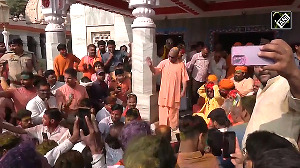The aggravating sectarian violence threatens to increase the conflict within the Pakistani society and destabilise it, writes Alok Bansal
On September 18, two blasts in the Hyderi locality of North Nazimabad in Karachi, which is dominated by Dawoodi Bohra community, claimed seven lives and injured 22.
One of the bombs was planted in the garbage dump near the Bohri mosque and another on a motorcycle that was parked outside a shop near the mosque. Other shops and vehicles in the vicinity were destroyed.
The victims mostly belonged to the Dawoodi Bohra community. Earlier during Ramzan, a powerful bomb was detected and diffused by the police in the same locality. The blasts indicated that puritanical proponent of Talibanised Islam, after targeting Ahmediyas, Shias, Ismailis and Barelvis have turned their ire towards the miniscule but economically significant Dawoodi Bohra community.
The attack, which came a day after the visit of Syedi Mufaddal Bhaisaheb Saifuddin -- the successor to the office of Da'i al-Mutlaq of the Dawoodi Bohras -- to Karachi, shows that sectarian assassins have turned their ire towards the half-a-million-strong Bohra community.
Bohra men and women are easily identifiable because of their distinctive attire within the sectarian tinderbox of Karachi.
On the same day, a car filled with explosives blew up as a bus carrying Shia pilgrims from Taftan at Pak-Iran border to Quetta, approached Digar area in Mastung district of Balochistan. The blast, 40 km from Quetta, killed three pilgrims and injured ten others.
A large number of Shia pilgrims from Pakistan, especially Hazaras from Balochistan, visit Shia religious places in Iran and Iraq by road. Many of these pilgrims transiting to and from Iran have been targeted by Sunni radical organisations like Lashkar-e- Janghavi.
The bus carrying 10 Shia pilgrims was being escorted by security personnel, but that did not prevent the terrorists from targeting it. The bus caught fire after the explosion and was totally burnt; three pilgrims died while the remaining seven were seriously injured.
Besides, the three security personnel accompanying them were also injured.
The killing of 10 persons and injuring of 32 others in two different incidents of sectarian violence in a single day shows the enormity of growing sectarian divide within Pakistan.
Although the genesis of sectarian conflict in Pakistan lies within the divisive 'Two Nation Theory', the sectarian violence made its appearance in Pakistan in the fifties, when anti-Ahmediya riots afflicted the State.
Anti-Shia violence began in 1963 and the state patronage accorded to certain Sunni outfits during the rule of General Zia-ul-Haq, has enhanced it considerably. Since then there has been systematic elimination of professionals belonging to minority sects, besides mutual killing of clerics and leaders of armed sectarian groups.
However, the level of violence has increased considerably ever since the Taliban decided to piggy back on sectarian outfits to expand its reach in the non-Pakhtoon areas of Pakistan.
The sectarian attacks have followed a copy book pattern, where in Sunni sectarian outfits target elites belonging to sectarian minorities whose religious orientation is well known on account of their eminence in their respective fields.
Besides, processions and gatherings associated with a minority sect like Ashura and Chelhum processions, funerals, worshippers at religious places, groups going for pilgrimage and processions organised by sectarian groups have been targeted regularly.
In keeping with the Taliban ideology they have not desisted from using suicide bombers to achieve their nefarious objectives. The reprisals from Shias by and large have been confined to targeted attacks on leadership of Sunni militant organisations and clerics spewing sectarian hatred.
There are however, some exceptions to this pattern.
The first is the targeting of Hazaras in Quetta and other parts of Balochistan. Hazaras belong to mongoloid stock and follow Twelver Shia (Ithna Ashari) faith. They inhabit Bamiyan province of Afghanistan. However, a large number of them have shifted to Pakistan and there is a significant population of Hazaras in Quetta.
On account of their mongoloid features, they are identified as Shias and have been targeted relentlessly. Of the 320 Shias, who lost their lives during the first eight months of this year, 100 were killed in Balochistan alone and almost all of them were Hazaras.
Baloch nationalists have often accused the state agencies of instigating sectarian violence to create division amongst the nationalists.
The other exceptions to the regular pattern of sectarian violence are seen in regions dominated by sectarian minorities like Gilgit-Baltistan in PoK and Parchinar in Kurram Agency of FATA, where they have the capacity to retaliate.
These are the areas, where pitched battles have been fought for days amongst sectarian militias. These are the areas where the local majority often perceives administration to be siding with the national majority. The last exception is Pakistan's largest city Karachi, which because of its huge population has large number of adherents of almost all the sects and sub-sects, which allows them to organise themselves and protest any infringement of their rights.
Growing radicalisation in Pakistan has reduced the societal tolerance of any deviation from one's own rituals and beliefs. This has not only created the fissures between the sects, but also amongst various sub-sects of the same sect.
Consequentially, within the fold of Sunni Islam, Sufi shrines are being targeted and even Barelvi clerics and processions, especially the Milad-un-Nabi processions are being attacked, as Wahabis and Deobandis consider Milad celebrations to be un-Islamic.
Similarly, Twelver Shias like Wahabis and other fanatic Sunni clerics, consider Ismailis (Aga Khanis) to be heretics, even Bohras (Mustaalis) are viewed with suspicion, although both of them are branches of Shia Islam.
Workers of Aga Khan Foundation and Aga Khan Education Service have long been targeted in various parts of Pakistan.
Even Zikris who live on the Makran coast and call themselves as Sunnis have been persecuted for their beliefs and practices.
The attempts have even been made to prevent them from undertaking their annual pilgrimage to Koh-e-Murad, undertaken in lieu of Haj.
There have been attempts to declare them as non-Muslims like Ahmediyas, who are not even allowed to call themselves as Muslims or their places of worship as mosques.
With the attack on Dawoodi Bohras, one more sectarian minority group has been brought on to the crosswire of radical Sunni outfits aligned with Taliban. The aggravating sectarian violence threatens to increase the conflict within the Pakistani society and destabilise it.
The sectarian faultline has the potential create fissures within every organ of the State. The state needs to check the onslaught of radical forces within its territory to instil a sense of security within sectarian minorities.
In the past many criminals accused of serious sectarian carnage have been allowed to roam free. The State needs to show its resolve by bringing them to law More significantly the state needs to deemphasising religion from the body politic.
The poisoning of juvenile minds with sectarian hatred needs to be stopped by amending the educational curriculum and the contents of the text books, which often promote hatred.







 © 2025
© 2025